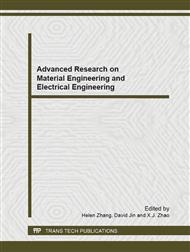[1]
Collett, T.S., 2004. Gas Hydrates as a Future Energy Resource. Sidebars: U.S. projects under way, 2004.
Google Scholar
[2]
Chatti, I., Delahaye, A., Fournaison, L., and Petitet, J.P., 2005. Benefits and Drawbacks of Clathrate Hydrates: a Review of Their Areas if Interest. Energy Conversion and Management, 46(2005)1333-1343.
DOI: 10.1016/j.enconman.2004.06.032
Google Scholar
[3]
Goel, N., Wiggins, M. and Shah, S., 2001. Analytical Modeling of Gas Recovery from in Situ Hydrates Dissociation. Journal of Petroleum Sciences and Engineering, 29(2001) 115-127.
DOI: 10.1016/s0920-4105(01)00094-8
Google Scholar
[4]
Holder, G.D., and Angert, P.F., 1982. Simulation of gas production from a reservoir containing both gas hydrates and free natural gas. Paper SPE 11105 presented at the 1982 Annual Technical Conference and Exhibition, New Orleans, Sept(1982)26–29.
DOI: 10.2118/11105-ms
Google Scholar
[5]
Holder, G.D., Angert, P.F., John, V.T., Yen, S., 1982. A thermodynamic evaluation of thermal recovery of gas from hydrates in the earth. J. Pet. Techno, (1982)1127–1132.
DOI: 10.2118/8929-pa
Google Scholar
[6]
Ji, C., Ahmadi, G., and Smith, D.H., 2004. Constant rate natural gas production from a well in a hydrate reservoir. Energy Conversion and Management, 44(2004) 2403-2423.
DOI: 10.1016/s0196-8904(03)00010-4
Google Scholar
[7]
Gudmundsson, J.S. and Mork, M., "Stranded gas to hydrate for storage and transport", 2001 International Gas Research Conference, Amsterdam (2001), November 5-8.
Google Scholar
[8]
Taylor, M., Dawe, R.A., and Thomas, S., "Fire and Ice: Gas Hydrate Transportation – A possibility for the Caribbean Region", SPE 81022, presented at the SPE Latin American and Caribbean Petroleum Engineering Conference held in Port-of-Spain, Trinidad, West Indies (2003), April 27-30.
DOI: 10.2118/81022-ms
Google Scholar
[9]
Yakushev, V.S. and Istomin, V.A., "Gas hydrates self-preservation effect", Physics and chemistry of Ice, Hokkaido University Press, Sapporo, Japan (1992), 136-139.
Google Scholar
[10]
Stern, L., Circone, S., Lirby, S. and Durham, W., "Anomalous preservation of pure methane hydrate at 1 atm", Journal of Physical Chemistry, 105 (2001), 1756-1762. Gudmundsson, J.S., Parlaktuna, M., and Khokhar, A.A., "Storing natural gas as frozen hydrate", SPE Production and Facility (1994), 69-73.
DOI: 10.1021/jp003061s
Google Scholar
[11]
Davidson, D.W., Garg, S.K., Gough, S.R., Handa, Y.P., Ratcliffe, C.I., Ripmeester, J.A., Tse, J.S., and Lawson, W.F., "Laboratory analysis of a naturally occurring gas hydrate from sediment of the Gulf of Mexico", Geochimica et Cosmochimica Acta, 50 (1986), 619-623.
DOI: 10.1016/0016-7037(86)90110-9
Google Scholar
[12]
Fitzgerald A. and Taylor M., "Offshore Gas-to-Solid Technology", SPE paper 71805, presented at the Offshore Europe Conference held in Aberdeen, UK (2001), 4-7 September.
Google Scholar
[13]
Gudmundsson, J.S. and Borrehaug, A., "Frozen hydrate for transport of natural gas", Proc. 2nd Intl. Conf. Natural Gas Hydrates, Toulouse, France (1996), June 2-6, 415-422.
Google Scholar
[14]
Gudmundsson, J.S., Mork, M. and Graff, O.F., "Hydrate non-thpipeline technology", Proc. 4 Intl. Conf. Gas Hydrates, Yokohama (2002), May 19-23, 997-1002.
Google Scholar
[15]
Gudmundsson, J.S., Hveding, F., and Borrehaug, A., "Frozen hydrate compared to LNG", Department of Petroleum Engineering and Applied Geophysics, Norwegian Institute of Technology, Trondheim, January (1995).
Google Scholar
[16]
Gudmundsson, J.S., Anderson, V., Levik, O.I., and Parlaktuna, M., "Hydrate Concept for Capturing Associated Gas", SPE 50598, the European Petroleum Conference, 20-22 October 1998, The Hague, Netherlands (1998), Conference Proceedings, 247- 258.
DOI: 10.2118/50598-ms
Google Scholar


